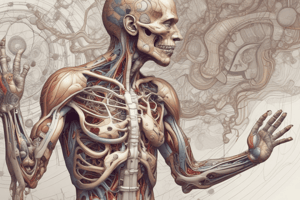Podcast
Questions and Answers
What type of bond is formed when two sugars combine to form a bigger sugar?
What type of bond is formed when two sugars combine to form a bigger sugar?
- Ionic bond
- Glycosidic linkage (correct)
- Peptide bond
- Hydrogen bond
What is the function of glucose in cellular metabolism?
What is the function of glucose in cellular metabolism?
- To synthesize proteins
- To store genetic information
- To replicate DNA
- To provide a ready source of energy to fuel cell metabolism (correct)
What is the name of the complex carbohydrate that is formed when many glucose molecules are linked together?
What is the name of the complex carbohydrate that is formed when many glucose molecules are linked together?
- Monosaccharide
- Polysaccharide (correct)
- Glycoprotein
- Disaccharide
What is the main form in which sugar is used by cells?
What is the main form in which sugar is used by cells?
What is the byproduct of glucose breakdown in the presence of oxygen?
What is the byproduct of glucose breakdown in the presence of oxygen?
What is the function of sugars in DNA and RNA?
What is the function of sugars in DNA and RNA?
What is the name of the type of sugar that is formed when two glucose molecules are linked together?
What is the name of the type of sugar that is formed when two glucose molecules are linked together?
What is the function of amino acids in the cell?
What is the function of amino acids in the cell?
What elements do amino acids always contain?
What elements do amino acids always contain?
What is the term for the process of breaking down glucose to release energy?
What is the term for the process of breaking down glucose to release energy?
Flashcards are hidden until you start studying
Study Notes
Survival Needs and Body Activities
- Five essential survival needs: communication, intake of oxygen, intake of raw materials and elimination of waste, protection, and body movement
- Corresponding body activities: transport systems, nervous and endocrine systems, ingestion of nutrients, elimination of waste, protection against external environment and microbial infection, and body movement
Communication
- Internal communication: nervous and endocrine systems involved in maintaining homeostasis and regulating vital body functions
- External communication: special senses, verbal and non-verbal activities, and nervous system
Transport Systems
- Blood, circulatory system, and lymphatic system involved in transporting oxygen, nutrients, and waste products
- Heart: a muscular sac that pumps blood throughout the body, maintaining blood pressure, and beats 65-75 times per minute at rest
- Lymphatic system: consists of lymph vessels, lymph nodes, and lymph, which filters out microbes and other materials, and returns to the bloodstream
Internal Communication
- Nervous and endocrine systems involved in maintaining homeostasis and regulating vital body functions
- Pathogenesis: main processes causing illness or disease, including inflammation, tumours, abnormal immune mechanisms, thrombosis, embolism, and infarction
Disease-Associated Terminology
- Acute: disease with sudden onset, often requiring urgent treatment
- Acquired: disorder that develops after birth
- Chronic: long-standing disorder that cannot usually be cured
- Congenital: disorder present at birth
- Sign: abnormality seen or measured by others
- Symptom: abnormality described by the patient
- Syndrome: collection of signs and symptoms that tend to occur together
Atomic Structure and Chemical Bonds
- Atoms consist of protons, neutrons, and electrons
- Electrons in outermost shell are important for chemical reactions
- Isotopes: atoms of an element with different numbers of neutrons in the nucleus, affecting atomic weight
Biological Molecules
- Carbohydrates: composed of carbon, oxygen, and hydrogen, with carbon atoms arranged in a ring
- Glucose: main form of sugar used by cells, can be broken down in the presence or absence of oxygen
- Polysaccharides: complex carbohydrates formed by linking monosaccharides together
- Proteins: composed of amino acids, which contain carbon, hydrogen, oxygen, nitrogen, and sometimes sulphur
- Importance of biological molecules: provide energy, form structures, and act as receptors on cell surfaces
Studying That Suits You
Use AI to generate personalized quizzes and flashcards to suit your learning preferences.




